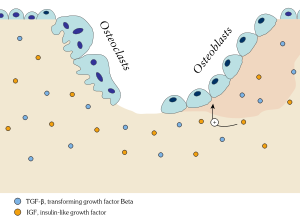- Ossification
-
 Bone is broken down by osteoclasts, and rebuilt by osteoblasts, both of which communicate through cytokine (TGF-β, IGF) signalling.
Bone is broken down by osteoclasts, and rebuilt by osteoblasts, both of which communicate through cytokine (TGF-β, IGF) signalling.
Ossification (or osteogenesis) is the process of laying down new bone material by cells called osteoblasts. It is synonymous with bone tissue formation. There are two processes resulting in the formation of normal, healthy bone tissue:[1] Intramembranous ossification is the direct laying down of bone into the primitive connective tissue (mesenchyme), while endochondral ossification involves cartilage as a precursor. In fracture healing, endochondral osteogenesis is the most commonly occurring process, for example in fractures of long bones treated by plaster of Paris, whereas fractures treated by open reduction and stabilization by metal plate and screws may heal by intramembranous osteogenesis.
Heterotopic ossification is a process resulting in the formation of bone tissue that is often atypical, at an extraskeletal location. Calcification is often confused with ossification. Calcification is synonymous with the formation of calcium-based salts and crystals within cells and tissue. It is a process that occurs during ossification, but not vice versa.
The exact mechanisms by which bone development is triggered remains unclear, but it involves growth factors and cytokines in some way.
Contents
Timetable for human ossification
Time period[2] Bones affected[2] Third month of embryonic development Ossification in long bones beginning Fourth month Most primary ossification centers have appeared in the diaphyses of bone. Birth to 5 years Secondary ossification centers appear in the epiphyses 5 years to 12 years in females, 5 to 14 years in males Ossification is spreading rapidly from the ossifcation centers and various bones are becoming ossified 17 to 20 years Bone of upper limbs and scapulae becoming completely ossified 18 to 23 years Bone of the lower limbs and os coxae become completely ossified 23 to 25 years Bone of the sternum, clavicles, and vertebrae become completely ossified By 25 years Nearly all bones are completely ossified Evolution
Several hypotheses have been proposed for how bone evolved as a structural element in vertebrates. One hypothesis is that bone developed from tissues that evolved to store minerals. Specifically, calcium-based minerals were stored in cartilage and bone was an exaptation development from this calcified cartilage.[3] However, other possibilities include bony tissue evolving as an osmotic barrier, or as a protective structure.
See also
- Dystrophic calcification
- Mechanostat, a model describing ossification and bone loss
- Ossicone, the horn-like (or antler-like) protuberances on the heads of giraffes and related species
- Osteogenesis imperfecta, a juvenile bone disease
- Fibrodysplasia ossificans progressiva, an extremely rare genetic disease which causes fibrous tissue (muscle, tendon, ligament etc.) to ossify when damaged
- Primrose syndrome, a rare genetic disease in which cartilage becomes ossified.
References
- ^ Caetano-Lopes J, Canhão H, Fonseca JE (2007). "Osteoblasts and bone formation". Acta reumatológica portuguesa 32 (2): 103–10. PMID 17572649.
- ^ a b Predicting Height from the Length of Limb Bones Part of: Examining Effects of Space Flight on the Skeletal System. Emily Morey-Holton. NASA Ames Research Center. Moffett Field, California
- ^ Donoghue PC, Sansom IJ (2002). "Origin and early evolution of vertebrate skeletonization". Microsc. Res. Tech. 59 (5): 352–72. doi:10.1002/jemt.10217. PMID 12430166.
Musculoskeletal system · connective tissue: bone and cartilage (TA A02.0, TH H3.01, GA 2.86–95) Cartilage perichondrium · fibrocartilage callus · metaphysis
cells (chondroblast · chondrocyte)
types (hyaline · elastic · fibrous)Bone OssificationCycleTypesRegionsStructureosteon / Haversian system · Haversian canals · Volkmann's canals · connective tissue (endosteum · periosteum) · Sharpey's fibres · enthesis · lacunae · canaliculi · trabeculae · medullary cavity · bone marrowShapesMusculoskeletal physiology: Bone/cartilage physiology Bone Bone density · Bone remodeling (Bone healing, Bone resorption, Osseointegration, Ossification, Osteolysis) · Bone age · Periosteal reactionCartilage Joint Teeth M: JNT
anat(h/c, u, t, l)/phys
noco(arth/defr/back/soft)/cong, sysi/epon, injr
proc, drug(M01C, M4)
Embryology of bones, joints, and muscles (GA 2.80, TE E5.0-2) Ossification Lower limbHeadcranium: Ossification of occipital bone · Ossification of frontal bone · Ossification of temporal bone · Ossification of sphenoid · Ossification of ethmoid
facial bones: Ossification of vomer (Sutura vomerina · Foramen vomerinum · Meatus vomerinus · Fissura vomerina) · Ossification of maxilla · Ossification of mandibleOtherOther M: JNT
anat(h/c, u, t, l)/phys
noco(arth/defr/back/soft)/cong, sysi/epon, injr
proc, drug(M01C, M4)
Categories:- Animal physiology
- Skeletal system
- Tissues
- Musculoskeletal system stubs
- Cell biology stubs
Wikimedia Foundation. 2010.
